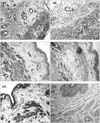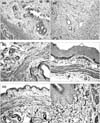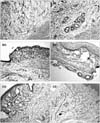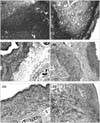Abstract
Purpose
As suggested by many investigators, the cause of age-related female sexual dysfunction is the decline of serum estrogen. We investigated the effects of estrogen on the nitric oxide synthase (NOS) and vascular endothelial growth factor (VEGF) expressions and the histologic composition in the uterus and proximal and distal vagina of rats.
Materials and Methods
Forty-five mature female Sprague-Dawley rats were randomly divided into three groups; the control group (C), the oophorectomy group (O), and the estrogen replacement group (E). The expression rates of neuronal NOS (nNOS), endothelial NOS (eNOS), VEGF and the changes of the collagen component in the uterus and proximal and distal vaginal tissues were investigated by immunohistochemical staining and Masson's trichrom staining.
Results
The expression rate of NOS was highest in the proximal vagina, and this was followed by the portion of the vagina distal to the uterus. The nNOS and eNOS expression rates were significantly decreased in the uterus and the proximal vagina of the E group (p<0.05), and they were increased in the uterus and proximal vagina of the O group (p<0.05). However, the VEGF expression rate was increased in only the uterus of E group. In all tissues, the collagen component was significantly decreased in the E group, while it was increased in the O group (p<0.05).
Figures and Tables
 | Fig. 1The mean serum 17β-estradiol. *: p-value (comparing the control group with the oophorectomy group)<0.001, †: p-value (comparing the oophorectomy group with the estrogen replaced group)<0.001. |
 | Fig. 2The mean expression percentage. (A) nNOS, (B) eNOS, (C) VEGF, (D) relative percentage of the collagen component, *: p-value (comparing the control group with the oophorectomy group)<0.05, †: p-value (comparing the oophorectomy group with the estrogen replaced group)<0.05. nNOS: neuronal nitric oxide synthase, eNOS: endothelial nitric oxide synthase, VEGF: vascular endothelial growth factor. |
 | Fig. 3Immunoreactivity pattern for neuronal nitric oxide synthase (nNOS) of rat uterus, the proximal vagina and the distal vagina. (A) nNOS expression in the uterus (×200, O: O group, E: E group), (B) the proximal vagina (×200, O: O group, E: E group), (C) the distal vagina (×200, O: O group, E: E group). |
 | Fig. 4Immunoreactivity pattern for endothelial nitric oxide synthase (eNOS) of rat uterus, the proximal vagina and the distal vagina. (A) eNOS expression in the uterus (×200, O: O group, E: E group), (B) the proximal vagina (×200, O: O group, E: E group), (C) the distal vagina (×200, O: O group, E: E group). |
 | Fig. 5Immunoreactivity pattern for vascular endothelial growth factor (VEGF) of rat uterus, the proximal vagina and the distal vagina. (A) VEGF expression in the uterus (×200, O: O group, E: E group), (B) the proximal vagina (×200, O: O group, E: E group), (C) the distal vagina (×200, O: O group, E: E group). |
References
1. Laumann EO, Paik A, Rosen RC. Sexual dysfunction in the United States: prevalence and predictors. JAMA. 1999. 281:537–544.
2. Bachmann GA. Sexual function in the perimenopause. Obstet Gynecol Clin North Am. 1993. 20:379–389.
3. Berman JR, McCarthy MM, Kyprianou N. Effect of estrogen withdrawal on nitric oxide synthase expression and apoptosis in the rat vagina. Urology. 1998. 51:650–656.
4. Zavara P, Sioufi R, Schipper HM, Begin LR, Brock GB. Nitric oxide mediated erectile activity is a testosterone dependent event: a rat erection model. Int J Impot Res. 1995. 7:209–219.
5. Gross SS, Wolin MS. Nitric oxide: pathophysiological mechanisms. Annu Rev Physiol. 1995. 57:737–769.
6. Marthol H, Hilz MJ. Female sexual dysfunction: a systematic overview of classification, pathophysiology, diagnosis and treatment. Fortschr Neurol Psychiatr. 2004. 72:121–135.
7. Semmens JP, Semmens EC. Sexual function and the menopause. Clin Obstet Gynecol. 1984. 27:717–723.
8. Levin RJ. The physiology of sexual function in women. Clin Obstet Gynaecol. 1980. 7:213–252.
9. Coope J. Hormonal and non-hormonal interventions for menopausal symptoms. Maturitas. 1996. 23:159–168.
10. Myers LS, Morokoff PJ. Physiological and subjective sexual arousal in pre- and postmenopausal women and postmenopausal women taking replacedment therapy. Psychophysiology. 1986. 23:283–292.
11. Dennerstein L, Dudley EC, Hopper JL, Burger H. Sexuality, hormones and the menopausal transition. Maturitas. 1997. 26:83–93.
12. Verkauf BS, Von Thron J, O'Brien WF. Clitoral size in normal women. Obstet Gynecol. 1992. 80:41–44.
13. Yoon HN, Chung WS, Park YY, Shim BS, Han WS, Kwon SW. Effects of estrogen on nitric oxide synthase and histological composition in the rabbit clitoris and vagina. Int J Impot Res. 2001. 13:205–211.
14. Baram DA. Berek JS, Adaxhi EY, Hillard PA, editors. Sexuality and sexual function. Novak's gynecology. 1996. 12th ed. Baltimore: Williams and Wilkins;279–298.
15. Tarcan T, Park K, Goldstein I, Maio G, Fassina A, Krane RJ, et al. Histomorphometric analysis of age-related structural changes in human clitoral-cavernosal tissue. J Urol. 1999. 161:940–944.
16. Sarrel PM. Ovarian hormones and vaginal blood flow: using laser Doppler velocimetry to measure effects in a clinical trial of post-menopausal women. Int J Impot Res. 1998. 10:Suppl 2. S91–S93.
17. Burnett AL, Lowenstein CJ, Bredt DS, Chang TS, Snyder SH. Nitric oxide: a physiologic mediator of penile erection. Science. 1992. 257:401–403.
18. Naftolin F, MacLusky NJ, Leranth CZ, Sakamoto HS, Garcia-Segura LM. The cellular effects of estrogens on neuroendocrine tissues. J Steroid Biochem. 1988. 30:195–207.
19. Hoyle CH, Stones RW, Robson T, Whitley K, Burnstock G. Innervation of vasculature and microvasculature of the human vagina by NOS and neuropeptide-containing nerves. J Anat. 1996. 188:633–644.
20. Hyder SM, Nawaz Z, Chiappetta C, Stancel GM. Identification of functional estrogen response elements in the gene coding for the potent angiogenic factor vascular endothelial growth factor. Cancer Res. 2000. 60:3183–3190.
21. Heryanto B, Lipson KE, Rogers PA. Effect of angiogenesis inhibitors on oestrogen-mediated endometrial endothelial cell proliferation in the ovariectomized mouse. Reproduction. 2003. 125:337–346.
22. Batra S, Al-Hijji J. Characterization of nitric oxide synthase activity in rabbit uterus and vagina: down regulation by estrogen. Life Sci. 1998. 62:2093–2100.
23. Al-Hijji J, Larsson I, Batra S. Effect of ovarian steroids on nitric oxide synthase in the rat uterus, cervix and vagina. Life Sci. 2001. 69:1133–1142.
24. Kang JS, Lee BJ, Ahn B, Kim DJ, Nam SY, Yun YW, et al. Expression of estrogen receptor alpha and beta in the uterus and vagina of immature rats treated with 17-ethinyl estradiol. J Vet Med Sci. 2003. 65:1293–1297.
25. Chambliss KL, Shaul PW. Estrogen modulation of endothelial nitric oxide synthase. Endocr Rev. 2002. 23:665–686.
26. Molero L, Garcia-Duran M, Diaz-Recasens J, Rico L, Casado S, Lopez-Farre A. Expression of estrogen receptor subtypes and neuronal nitric oxide synthase in neutrophils from women and men: regulation by estrogen. Cardiovasc Res. 2002. 56:43–51.
27. Traish AM, Kim NN, Huang YH, Min K, Munarriz R, Goldstein I. Sex steroid hormones differentially regulate nitric oxide synthase and arginase activities in the proximal and distal rabbit vagina. Int J Impot Res. 2003. 15:397–404.




 PDF
PDF ePub
ePub Citation
Citation Print
Print



 XML Download
XML Download